Ryobi SSP300 User Manual [en, es, fr]
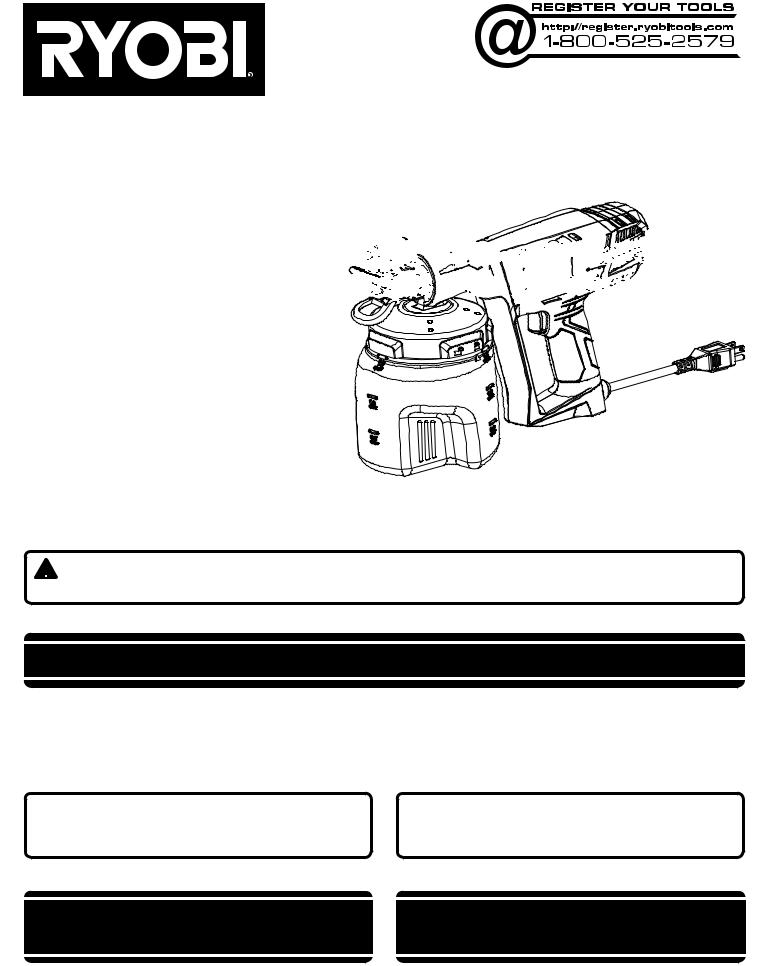
OPERATOR’S MANUAL
MANUEL D’UTILISATION
MANUAL DEL OPERADOR
POWER PAINT SPRAYER 



































 TOOL
TOOL 


























PISTOLET À PEINDRE ÉLECTRIQUE
ROCIADOR ELÉCTRICO DE PINTURA
SSP300
Your power paint sprayer tool has been engineered and manufactured to our high standard for dependability, ease of operation, and operator safety. When properly cared for, it will give you years of rugged, trouble-free performance.
 WARNING: To reduce the risk of injury, the user must read and understand the operator’s manual before using this product.
WARNING: To reduce the risk of injury, the user must read and understand the operator’s manual before using this product.
Thank you for your purchase.
SAVE THIS MANUAL FOR FUTURE REFERENCE
Cette pistolet à peindre électrique a été conçue et fabriquée conformément à nos strictes normes de fiabilité, simplicité d’emploietsécuritéd’utilisation.Correctemententretenue,elle vous donnera des années de fonctionnement robuste et sans problème.
 AVERTISSEMENT : Pour réduire les risques de blessures, l’utilisateur doit lire et veiller à bien comprendre le manuel d’utilisation avant d’employer ce produit.
AVERTISSEMENT : Pour réduire les risques de blessures, l’utilisateur doit lire et veiller à bien comprendre le manuel d’utilisation avant d’employer ce produit.
Merci de votre achat.
Su herramienta para rociador eléctrico de pintura ha sido diseñado y fabricado de conformidad con nuestras estrictas normas para brindar fiabilidad, facilidad de uso y seguridad para el operador. Con el debido cuidado, le brindará muchos años de sólido y eficiente funcionamiento.
 ADVERTENCIA: Para reducir el riesgo de lesiones, el usuario debe leer y comprender el manual del operador antes de usar este producto.
ADVERTENCIA: Para reducir el riesgo de lesiones, el usuario debe leer y comprender el manual del operador antes de usar este producto.
Le agradecemos su compra.
CONSERVER CE MANUEL POUR |
GUARDE ESTE MANUAL PARA |
FUTURE RÉFÉRENCE |
FUTURAS CONSULTAS |

|
TABLE OF CONTENTS |
Introduction........................................................................................................................................................................ |
2 |
Warranty............................................................................................................................................................................. |
2 |
Important Safety Instructions............................................................................................................................................. |
3 |
Specific Safety Rules......................................................................................................................................................... |
4 |
Symbols............................................................................................................................................................................. |
5 |
Electrical............................................................................................................................................................................. |
6 |
Features............................................................................................................................................................................. |
7 |
Assembly............................................................................................................................................................................ |
7 |
Operation....................................................................................................................................................................... |
8-9 |
Maintenance................................................................................................................................................................. |
9-10 |
Troubleshooting................................................................................................................................................................ |
11 |
Figure Numbers (Illustrations).................................................................................................................................... |
12-13 |
Parts Ordering / Service..................................................................................................................................... |
Back page |
|
INTRODUCTION |
This product has many features for making its use more pleasant and enjoyable. Safety, performance, and dependability have been given top priority in the design of this product making it easy to maintain and operate.
WARRANTY
RYOBI® POWER TOOL - LIMITED TWO YEAR WARRANTY AND 90 DAY EXCHANGE POLICY
One World Technologies, Inc., warrants its RYOBI® power tools with the following conditions:
90-DAY EXCHANGE POLICY: During the first 90 days after date of purchase, you may either request service under this warranty or you may exchange any RYOBI® power tool which does not work properly due to defective workmanship or materials by returning the power tool to the dealer from which it was purchased. To receive a replacement power tool or requested warranty service, you must present proof of purchase and return all original equipment packaged with the original product. The replacement power tool will be covered by the limited warranty for the balance of the two year period from the date of the original purchase.
WHAT THIS WARRANTY COVERS: This warranty covers all defects in workmanship or materials in your RYOBI® power tool for a period of two years from the date of purchase. With the exception of batteries, power tool accessories are warranted for ninety (90) days. Batteries are warranted for two years.
HOW TO GET SERVICE: Just return the power tool, properly packaged and postage prepaid, to an Authorized Service Center. You can obtain the location of the Service Center nearest you by contacting a service representative at One World Technologies, Inc., P.O. Box 1207, Anderson, SC 29622-1207, by calling 1-800-525-2579 or by logging on to www.ryobitools.com. When you request warranty service, you must also present proof of purchase documentation, which includes the date of purchase (for example, a bill of sale). We will repair any faulty workmanship, and either repair or replace any defective part, at our option. We will do so without any charge to you. We will complete the work in a reasonable time, but, in any case, within ninety (90) days or less.
WHAT’S NOT COVERED: This warranty applies only to the original purchaser at retail and may not be transferred. This warranty only covers defects arising under normal usage and does not cover any malfunction, failure or defects resulting from misuse, abuse, neglect, alteration, modification or repairs by other than Authorized Service Centers. One World Technologies, Inc. makes no warranties, representations or promises as to the quality or performance of its power tools other than those specifically stated in this warranty.
ADDITIONAL LIMITATIONS: Any implied warranties granted under state law, including warranties of merchantability or fitness for a particular purpose, are limited to two years from the date of purchase. One World Technologies, Inc. is not responsible for direct, indirect, or incidental damages, so the above limitations and exclusions may not apply to you. This warranty gives you specific legal rights, and you may also have other rights which vary from state to state.
2 — English

IMPORTANT SAFETY INSTRUCTIONS
WARNING:
SAVE THESE INSTRUCTIONS. To reduce the risks of fire or explosion, electric shock, and the injury to persons, read and understand all instructions included in this manual. Be familiar with the controls and the proper usage of the equipment.
READ ALL INSTRUCTIONS
KNOW YOUR POWER TOOL. Read the operator’s manual carefully. Learn the machine’s applications and limitations as well as the specific potential hazards related to this tool.
WARNING: To reduce the risk of fire or explosion:
Do not spray flammable or combustible materials near an open flame or sources of ignition such as cigarettes, motors, and electrical equipment.
For units intended for use with only water-based or mineral spirit-type materials with a minimum flash point of 60°C (140°F), do not spray or clean with liquids having a flash point less than 60°C (140°F).
Paint or solvent flowing through the equipment is able to result in static electricity. Static electricity creates a risk of fire or explosion in the presence of paint or solvent fumes. All parts of the spray system, including the pump, spray gun, and objects in and around the spray area shall be properly grounded to protect against static discharge and sparks.
Verify that all containers and collection systems are grounded to prevent static discharge.
Connect to a grounded outlet and use grounded extension cords. Do not use a 3-to-2 adapter.
Do not use a paint or a solvent containing halogenated hydrocarbons.
Keep spray area well ventilated. Keep a good supply of fresh air moving through the area. Keep pump assembly in a well-ventilated area.
Do not smoke in the spray area.
Do not operate light switches, engines, or similar sparkproducing products in the spray area.
Keep area clean and free of paint or solvent containers, rags, and other flammable materials.
Know the contents of the paints and solvents being sprayed. Read all Material Safety Data Sheets (MSDS) and container labels provided with the paints and solvents. Follow the paint and solvent manufacturer’s safety instructions.
Fire extinguisher equipment shall be present and working.
WARNING: To reduce the risk of skin injection:
Do not aim the nozzle at, or spray any person or animal.
Keep hands and other body parts away from the discharge. For example, do not try to stop leaks with any part of the body.
Always use the spray tip. Do not spray without spray tip in place.
Only use a spray tip specified by the manufacturer.
Use caution when cleaning and changing spray tips. In the case where the spray tip clogs while spraying, follow the manufacturer’s instructions for turning off the unit before removing the spray tip to clean.
Do not leave the unit energized while unattended. When the unit is not in use, turn off the unit in accordance with the manufacturer’s instructions.
High pressure spray is able to inject toxins into the body and cause serious bodily injury. In the event that injection occurs, seek medical attention immediately.
Check parts for signs of damage. Replace any damaged parts.
This system is capable of producing 2500 psi. Only use replacement parts or accessories that are specified by the manufacturer and that are rated a minimum of 2500 psi.
Know how to stop the unit quickly. Be thoroughly familiar with the controls.
Verify that all connections are secure before operating this unit.
For household use only.
WARNING: To reduce the risk of injury:
Do not operate or spray near children. Keep children away from equipment at all times.
Do not overreach or stand on an unstable support. Keep effective footing and balance at all times.
Stay alert and watch what you are doing.
Do not operate the unit when fatigued or under the influence of drugs or alcohol.
3 — English

SPECIFIC SAFETY RULES
Keep guards in place and in working order. Never operate the tool with any guard or cover removed. Make sure all guards are operating properly before each use.
To reduce the risk of injury, keep children and visitors away. All visitors should wear safety glasses and be kept a safe distance from work area.
Keep the area of operation clear of all persons, particularly small children, and pets.
Use right tool. Don’t force tool or attachment to do a job it was not designed for. Don’t use it for a purpose not intended.
Do not operate the equipment while barefoot or when wearing sandals or similar lightweight footwear. Wear protective footwear that will protect your feet and improve your footing on slippery surfaces.
Exercise caution to avoid slipping or falling.
Always wear eye protection with side shields marked to comply with ANSI Z87.1. Following this rule will reduce the risk of serious personal injury.
Use only recommended accessories. The use of improper accessories may cause risk of injury.
Follow the maintenance instructions specified in this manual.
Check damaged parts. Before further use of the tool, a guard or other part that is damaged should be carefully checked to determine that it will operate properly and perform its intended function. Check for alignment of moving parts, binding of moving parts, breakage of parts, mounting, and any other conditions that may affect its operation. A guard or other part that is damaged must be properly repaired or replaced by an authorized service center to avoid risk of personal injury.
Never leave tool running unattended. Turn power off.
Don’t leave tool until it comes to a complete stop.
Be thoroughly familiar with controls. Know how to stop the product quickly.
Keep tool dry, clean, and free from oil and grease.
Always use a clean cloth when cleaning. Never use brake fluids, gasoline, petroleum-based products, or any solvents to clean tool.
Do not use tool if switch does not turn it off. Have defective switches replaced by an authorized service center.
Before cleaning, repairing, or inspecting, shut off the motor and make certain all moving parts have stopped.
Avoid dangerous environment. Don’t use in damp or wet locations or expose to rain. Keep work area well lit.
Never direct a paint stream toward people or pets, or any electrical device.
Never start the machine if ice has formed in any part of the equipment.
WARNING: High pressure spray can be dangerous if subject to misuse. The spray must not be directed at persons, animals, electrical devices, or the machine itself.
Keep away from hot parts.
Check bolts and nuts for looseness before each use. A loose bolt or nut may cause serious motor problems.
Before storing, allow the product to cool.
Store in a cool, well-ventilated area, safely away from spark and/or flame-producing equipment.
When servicing use only identical replacement parts.
Use of any other parts may create a hazard or cause product damage.
Never use the sprayer without a spray tip installed.
An injection injury can lead to possible amputation.
See a physician immediately.
Never put your hand in front of the spray tip when in use. Gloves will not always provide protection against an injection injury.
Wear clothing to keep paint off skin and hair, along with a mask or respirator during use. Paints, solvents, and other materials can be harmful if inhaled or if they come into contact with the body.
Always unplug the sprayer and shut the unit off before servicing, cleaning the tip or guard, changing the tip, or leaving unattended.
Plastic can cause sparks. Never hang plastic to enclose a spray area. Do not use plastic drop cloths when spraying flammable materials.
Do not spray outdoors on windy days.
Do not attempt to clean or unclog the spray tip with your finger.
Save these instructions. Refer to them frequently and use them to instruct other users. If you loan someone this tool, loan them these instructions also.
4 — English

SYMBOLS
The following signal words and meanings are intended to explain the levels of risk associated with this product.
SYMBOL |
SIGNAL |
MEANING |
|
|
|
|
DANGER: |
Indicates an imminently hazardous situation, which, if not avoided, will result |
|
in death or serious injury. |
|
|
|
|
|
|
|
|
WARNING: |
Indicates a potentially hazardous situation, which, if not avoided, could result |
|
in death or serious injury. |
|
|
|
|
|
|
|
|
CAUTION: |
Indicates a potentially hazardous situation, which, if not avoided, may result in |
|
minor or moderate injury. |
|
|
|
|
|
|
|
|
CAUTION: |
(Without Safety Alert Symbol) Indicates a situation that may result in property |
|
damage. |
|
|
|
Some of the following symbols may be used on this product. Please study them and learn their meaning. Proper interpretation of these symbols will allow you to operate the product better and safer.
SYMBOL |
NAME |
DESIGNATION/EXPLANATION |
|
|
Safety Alert |
Indicates a potential personal injury hazard. |
|
|
|
|
|
|
Read The Operator’s Manual |
To reduce the risk of injury, user must read and understand |
|
|
operator’s manual before using this product. |
||
|
|
||
|
|
|
|
|
Eye Protection |
Always wear eye protection with side shields marked to comply |
|
|
with ANSI Z87.1. |
||
|
|
||
|
|
|
|
V |
Volts |
Voltage |
|
|
|
|
|
A |
Amperes |
Current |
|
|
|
|
|
Hz |
Hertz |
Frequency (cycles per second) |
|
|
|
|
|
|
Alternating Current |
Type of current |
|
|
|
|
|
PSI |
Pressure |
Pressure is measured in pounds per square inch |
|
|
|
|
|
GPH |
Flow Rate |
Flow rate is measured in maximum gallons of paint sprayed per |
|
hour |
|||
|
|
||
|
|
|
CALIFORNIA PROPOSITION 65
 WARNING:
WARNING:
This product, and the paints designed to be applied with this product, may contain chemicals, including lead, known to the State of California to cause cancer, birth defects, or other reproductive harm. Wash hands after handling.
5 — English
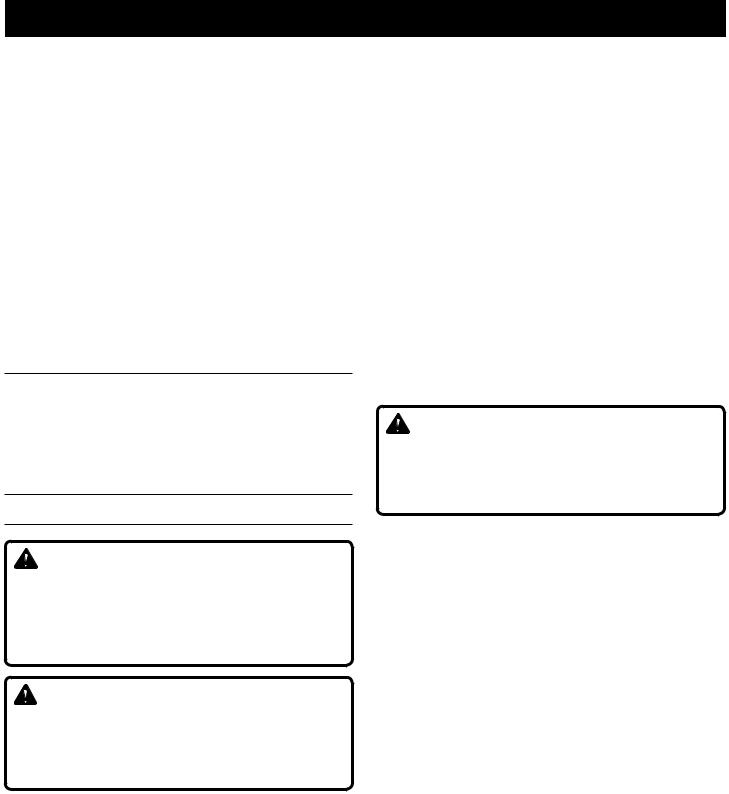
ELECTRICAL
EXTENSION CORDS
Be sure to use an extension cord that has the capacity to handle the current the product will draw. An undersized cord will cause a drop in line voltage, resulting in overheating and loss of power. Use the chart to determine the minimum wire size required in an extension cord. Only round jacketed cords listed by Underwriter’s Laboratories (UL) should be used.
When working outdoors with a product, use an extension cord that is designed for outside use. This type of cord is designated with “W-A” or “W” on the cord’s jacket.
Before using any extension cord, inspect it for loose or exposed wires and cut or worn insulation.
A proper extension cord is available at an authorized service center.
If two extension cords are needed, knot them together to prevent them from becoming disconnected during use. Make the knot as shown in figure 1, then connect the plug end of once extension cord into the receptacle end of the other.
**Ampere rating (on product data plate) |
|
|
|
|||
|
0-2.0 |
2.1-3.4 3.5-5.0 |
5.1-7.0 |
7.1-12.0 |
12.1-16.0 |
|
|
|
|
|
|
||
Cord Length |
|
Wire Size (A.W.G.) |
|
|
||
|
|
|
|
|
|
|
25' |
16 |
16 |
16 |
16 |
14 |
14 |
50' |
16 |
16 |
16 |
14 |
14 |
12 |
|
|
|
|
|
|
|
100' |
16 |
16 |
14 |
12 |
10 |
— |
**Used on 12 gauge - 20 amp circuit.
NOTE: AWG = American Wire Gauge
WARNING:
Keep the extension cord clear of the working area. Position the cord so that it will not get caught on lumber, tools, or other obstructions while you are working with a power tool. Failure to do so can result in serious personal injury.
ELECTRICAL CONNECTION
This product is powered by a precision-built electric motor. It should be connected to a power supply that is 120 V, AC only (normal household current), 60 Hz. Do not operate this product on direct current (DC). A substantial voltage drop will cause a loss of power and the motor will overheat. If the product does not operate when plugged into an outlet, double check the power supply.
GROUNDING INSTRUCTIONS
See Figure 1, page 12.
This product must be grounded. In the event of a malfunction or breakdown, grounding provides a path of least resistance for electric current to reduce the risk of electric shock. This product is equipped with an electric cord having an equipment-grounding conductor and a grounding plug. The plug must be plugged into a matching outlet that is properly installed and grounded in accordance with all local codes and ordinances.
Do not modify the plug provided. If it will not fit the outlet, have the proper outlet installed by a qualified electrician.
WARNING:
Improper installation of a grounded plug increase the risk of electric shock. When repair or replacement of the cord or plug is required, take the tool to an authorized service center.
Check with a qualified electrician or service personnel if the grounding instructions are not completely understood, or if in doubt as to whether the product is properly grounded.
Repair or replace a damaged or worn cord immediately.
This product is for use on a nominal 120 V circuit and has a grounding plug similar to the plug illustrated in figure 1. Only connecttheproducttoanoutlethavingthesameconfiguration as the plug. Do not use an adapter with this product.
WARNING:
Check extension cords before each use. If damaged replace immediately. Never use the product with a damaged cord since touching the damaged area could cause electrical shock resulting in serious injury.
6 — English
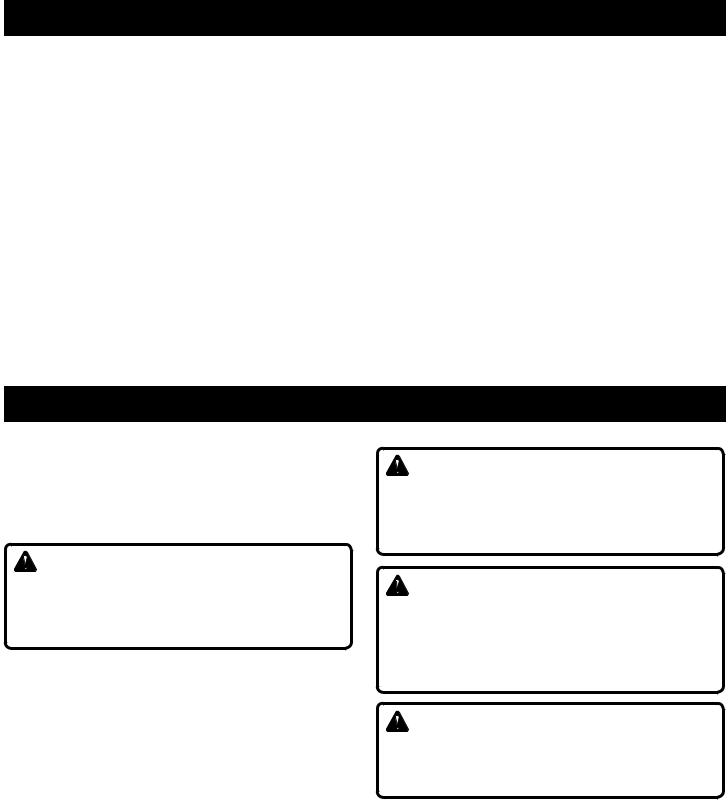
FEATURES
PRODUCT SPECIFICATIONS
Flow Rate.................................................................................................................................................................... |
5.5 GPH |
Container Size................................................................................................................................................................ |
1.5 qt. |
Input....................................................................................................................................... |
120 V, 60 Hz, AC only, 1.4 Amp |
KNOW YOUR POWER SPEED SPRAYER
See Figure 2, page 12.
The safe use of this product requires an understanding of the information on the product and in this operator’s manual as well as a knowledge of the project you are attempting. Before use of this product, familiarize yourself with all operating features and safety rules.
GRIPZONE™ TECHNOLOGY
The sprayer features Gripzone™ technology for improved comfort with a positive grip.
INNOVATIVE MOTOR DESIGN
The innovative motor design means less vibration and noise when using your sprayer.
QUICK-LOCK PAINT CONTAINER
The quick-lock paint container is easy to install and remove.
PRO-TIP™ REVERSIBLE SPRAY TIP
Reversible spray tip rotates 180º to clear clogs quickly.
ASSEMBLY
UNPACKING
This product has been shipped completely assembled.
nCarefully remove the product and any accessories from the box. Make sure that all items listed in the packing list are included.
WARNING:
Do not use this product if it is not completely assembled or if any parts appear to be missing or damaged. Use of a product that is not properly and completely assembled could result in serious personal injury.
nInspect the product carefully to make sure no breakage or damage occurred during shipping.
nDo not discard the packing material until you have carefully inspected and satisfactorily operated the product.
nIf any parts are damaged or missing, please call 1-800-525-2579 for assistance.
PACKING LIST
Power Paint Sprayer with Quick-Lock Container Replacement Atomizer Valve Assembly Cleaning Brush
Lubricant Operator’s Manual
WARNING:
If any parts are damaged or missing do not operate this product until the parts are replaced. Use of this product with damaged or missing parts could result in serious personal injury.
WARNING:
Do not attempt to modify this product or create accessories not recommended for use with this product. Any such alteration or modification is misuse and could result in a hazardous condition leading to possible serious personal injury.
WARNING:
Do not connect to power supply until assembly is complete. Failure to comply could result in accidental starting and possible serious personal injury.
7 — English
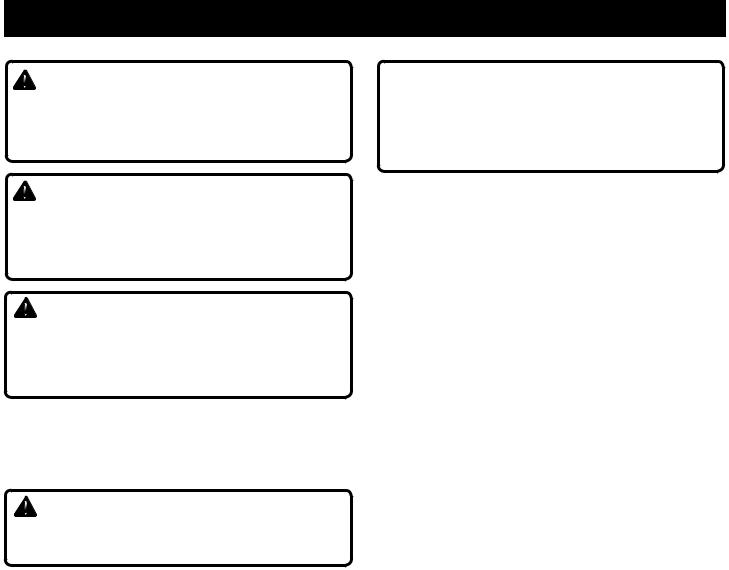
OPERATION
WARNING:
Do not allow familiarity with this product to make you careless. Remember that a careless fraction of a second is sufficient to inflict serious injury.
 WARNING:
WARNING:
To reduce the risk of injection, do not point sprayer at any part of the body or person. In case of skin injection, seek medical attention immediately. Do not use without spray tip in place.
WARNING:
Always wear eye protection with side shields marked to comply with ANSI Z87.1. Failure to do so could result in fluids entering your eyes resulting in possible serious injury.
WARNING:
Do not use any attachments or accessories not recommended by the manufacturer of this product. The use of attachments or accessories not recommended can result in serious personal injury.
APPLICATIONS
You may use this product for the purpose listed below:
Interior and exterior painting and staining of decks, outdoor furniture, fences, and walls
WARNING:
Risk of fire or explosion. Spray area must be well-venti- lated and away from sparks or flames.
FILLING SPRAYER WITH PAINT/STAIN
See Figures 3 - 4, page 12.
Remove and discard any skin that has formed on top of the paint or stain, then thoroughly mix the material in its original container before beginning.
NOTE: Older containers of stain and paint may need to be strained before use.
Unplug the sprayer.
Remove the quick-lock container by twisting counterclockwise so that the arrow on the container lines up with the “unlock” symbol on the lid.
Fill the container with paint or stain as desired. Do not fill above the max fill (1.5 qt.) mark on the container.
Reinstall the container on the sprayer and twist clockwise so that the arrow on the container lines up with the “lock” symbol on the lid.
OPERATING THE SPRAYER
See Figures 5 - 7, pages 12 - 13.
Ensure the surface to be painted is free of dust, dirt, and grease.
Mask or cover any areas not intended to be painted or stained. Be aware of wind that may cause your paint or stain to spray into areas not desired. Always use drop cloths or other cover to protect areas that are not intended to be painted or stained.
Place a line of lubricant on the piston. To gain access to the piston, follow the instructions in Cleaning the Sprayer for Storage in the Maintenance section of this manual.
Re-assemble the spray tip assembly.
The tip guard may be set to spray paint in either a horizontal or vertical pattern. To change the direction of the spray, loosen the metal collar of the spray tip assembly by turning it clockwise. Adjust the spray tip and tip guard as shown, and tighten the metal collar to secure the spray tip assembly.
Fill the quick-lock paint container with no more than 1.5 quarts of desired paint or stain.
Plug in the sprayer.
Pull the switch trigger to spray paint. Release the switch trigger to stop paint spray.
Practice spraying on a piece of scrap material to test your spray pattern and to prime the pump before beginning. If you cannot get a good spray pattern with an even amount of paint or stain throughout, refer to the Troubleshooting section later in this manual.
NOTE: The pump must be primed after every paint change and at first use after storing. Spray paint at a scrap surface for at least 20 seconds to prime.
To create an even coating over the entire surface:
•Move your arm at a steady rate of speed and make sure to move your entire arm, not just your wrist.
•Keep the sprayer an even distance from the area being sprayed, which should be between 8 to 10 inches from the tip of the sprayer to the surface being sprayed.
8 — English
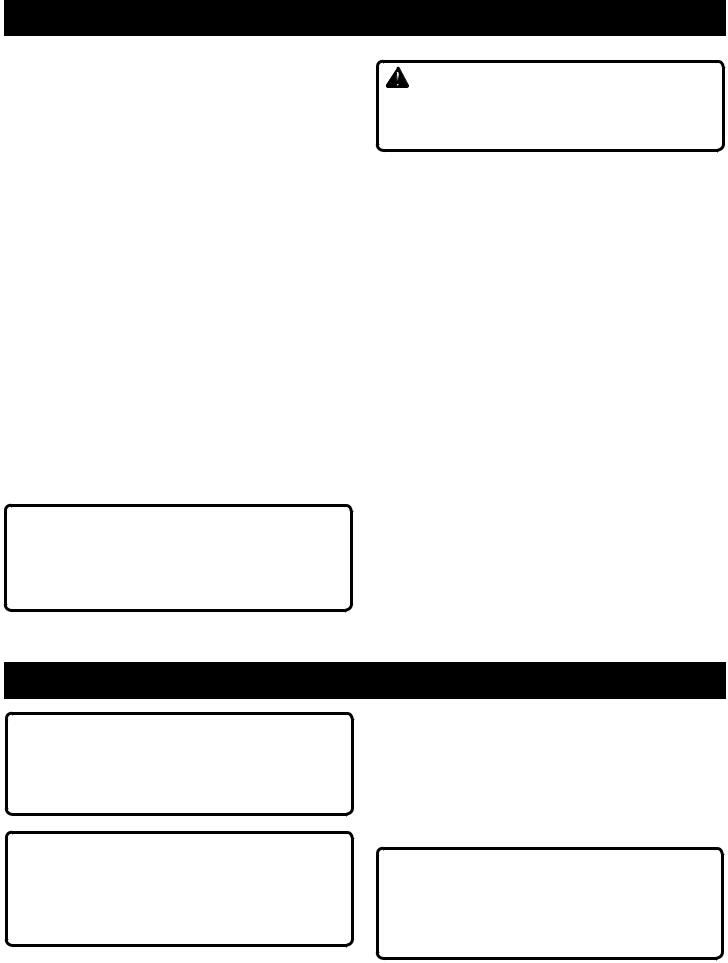
OPERATION
•Depress the trigger to begin the spray off the material you want to paint. Operate the sprayer in straight horizontal or vertical strokes across the surface being painted, then release the trigger off the material to end the stroke.
NOTE: For spray quality consistency when using thinner paints, it may be necessary to keep the trigger depressed between strokes.
When finished, unplug the sprayer, return any unused paint or stain to its original container, and thoroughly clean the sprayer.
CLEARING A PAINT CLOG
See Figure 8, page 13.
If paint is not flowing freely through the spray tip or the surface does not show an even coat of paint, the spray tip may be clogged. Reversing the spray tip can help to free the clog.
Twist the spray tip so that the pointed end is turned toward you.
Point the paint sprayer toward a piece of scrap material.
Press the trigger until paint flows through the spray tip. This should clear the clog.
Turn the spray tip so that the pointed end is facing away from you.
Test the sprayer on a piece of scrap material before you resume painting.
CAUTION:
It is important to thoroughly clean the sprayer after each use or when changing colors. Allowing paint or stain to remain in an idle tool for an extended period can cause its moving pieces to seize up.
WARNING:
Do not clean with any flammable liquids such as paint stripper, paint remover, brush cleaner, mineral spirits, lacquer thinner, turpentine, acetone, gasoline, kerosene, etc.
CLEANING THE SPRAYER AFTER USE
The solution used to clean the sprayer is determined by the type of material that has been sprayed. For anything other than latex material, follow the material manufacturer’s directions for appropriate clean-up.
To clean the sprayer for short term storage:
Unplug the sprayer.
If you haven’t already done so, remove the paint container and return any unused paint or stain to its original container.
Fill the paint container with lukewarm water (for water based paints) or non-flammable solvent (for oil-based paints or varnish, or any other non-flammable paint thinner (following the use of oil-based products).
NOTE: For best results, clean the container first.
Reinstall the paint container.
Plug in the sprayer.
Spray the solution onto a piece of cardboard or other scrap material. Continue spraying until all the solution is used.
Unplug the sprayer.
Place a line of lubricant on the piston. To gain access to the piston, follow the instructions in Cleaning the Sprayer for Storage in the Maintenance section of this manual.
Use a damp cloth to wipe the exterior of the sprayer. The unit is now ready to put away.
MAINTENANCE
 WARNING:
WARNING:
When servicing, use only identical replacement parts. Use of any other parts could create a hazard or cause product damage.
GENERAL MAINTENANCE
NOTE: Always unplug the unit before attempting a service operation.
Avoid using solvents when cleaning plastic parts. Most plastics are susceptible to damage from various types of commercial solvents and may be damaged by their use. Use clean cloths to remove dirt, dust, oil, grease, etc.
 WARNING:
WARNING:
Always wear eye protection with side shields marked to comply with ANSI Z87.1. Failure to do so could result in fluids entering your eyes resulting in possible serious injury.
 WARNING:
WARNING:
Do not at any time let brake fluids, gasoline, penetrating oils, etc., come in contact with plastic parts. Chemicals can damage, weaken, or destroy plastic which could result in serious personal injury.
9 — English

MAINTENANCE
CLEANING THE SPRAYER FOR STORAGE
See Figure 9, page 13.
When you’ve finished your project and are ready to store the sprayer, a thorough cleaning and lubrication is recommended.
Unplug the sprayer.
Remove the paint container.
If you haven’t already done so, return any unused paint or stain to its original container.
Fill the paint container with lukewarm water (for water based paints) or non-flammable solvent (for oil-based paints or varnish), or any other non-flammable paint thinner (following the use of oil-based products).
NOTE: For best results, clean the container first.
Reinstall the paint container.
Plug in the sprayer.
Spray the solution onto a piece of cardboard or other scrap material. Continue spraying until all the solution is used.
Unplug the sprayer.
Remove the paint container.
Remove the suction tube and filter.
Remove the installed spray tip by loosening the metal collar and turning the tip guard counterclockwise.
Remove the atomizer valve assembly and tip saddle. If the tip saddle is difficult to remove, you may use the end of the spray tip to push it out.
Remove the locking nut by turning it counterclockwise.
Slide the pump housing assembly/container lid forward off the sprayer.
Pull the piston and spring off the pump housing.
Using the provided cleaning brush and a solution determined by the last type of paint or stain sprayed, clean all of the above parts thoroughly.
NOTE: Make sure to scrub thoroughly inside the pump housing opening so that no paint or stain material is left behind.
Clean the vent hole in the pump housing using a straightened paper clip or toothpick.
To reassemble:
Place a line of lubricant on the piston.
NOTE: Once the provided lubricant has been used, vegetable oil may be substituted.
Slide the spring back onto the piston.
Insert the piston and spring assembly inside the back of the pump housing.
Replace the pump housing assembly/container lid into the sprayer.
Replace the locking nut on the sprayer housing by pushing in while rotating clockwise to secure.
Insert the atomizer valve assembly and tip saddle into the pump housing front opening.
NOTE: The atomizer valve assembly can be used to guide the tip saddle into the tip guard.
Replace the spray tip and rotate the tip guard clockwise to secure.
Reinstall the suction tube and filter.
Reinstall the paint container.
The sprayer is now ready to be stored.
REPLACINGTHEATOMIZERVALVEASSEMBLY
See Figure 10, page 13.
The atomizer valve causes the paint or stain material to spin as it comes out of the sprayer. After 7 to 10 gallons of paint or stain, the atomizer valve may no longer produce a good spray pattern and may need to be replaced.
To replace:
Unplug the sprayer.
Rotate the tip guard counterclockwise and remove.
Remove the atomizer valve assembly and discard. NOTE: Do not discard the tip or tip saddle.
Install the new atomizer valve assembly.
NOTE: If the tip saddle is not installed, the paint sprayer will not work.
Replace the spray tip and tip guard and rotate clockwise to secure.
10 — English

TROUBLESHOOTING
PROBLEM |
CAUSE |
POSSIBLE SOLUTION |
Motor does not run. |
Sprayer is not plugged in. |
Make sure unit is plugged in. |
|
Breaker is tripped. |
Reset breaker. |
|
|
|
Motor overheats. |
Piston has seized up. |
Thoroughly clean the sprayer using long-term |
|
|
storage cleaning instructions in the Maintenance |
|
|
section of this manual. |
|
Extension cord is too long. |
Use only the size extension cord recommended |
|
|
previously in this manual. |
|
Continuous spray operation. |
Release trigger at the end of each pass to allow |
|
|
the motor to cool. |
|
|
|
Motor has a low hum but does |
Piston has seized up. |
Thoroughly clean the sprayer using long-term |
not spray. |
|
storage cleaning instructions in the Maintenance |
|
|
section of this manual. |
|
|
|
Motor seems to be running |
Suction tube and filter are loose or |
Reinstall or replace suction tube and filter as |
properly but doesn’t spray. |
damaged. |
needed. |
|
Atomizer valve is clogged or worn out. |
Clean or replace atomizer valve assembly. |
|
Material being sprayed is too thick. |
Follow material manufacturer’s directions and |
|
|
thin material as needed. |
|
Plugged spray tip or intake filter; |
Thoroughly clean the sprayer and, if necessary, |
|
worn piston. |
replace piston*, using storage cleaning instruc- |
|
|
tions in the Maintenance section of this manual. |
|
|
|
Paint will not spray through |
Spray tip is clogged |
Reverse the spray tip and press trigger |
the tip |
|
|
|
|
|
Sprayed material is spitting or |
Paint container volume is getting low. |
Refill paint container. |
globbing up. |
Material being sprayed is too thick. |
Follow material manufacturer’s directions to thin |
|
||
|
|
material as needed. |
|
Suction tube is loose. |
Reinstall suction tube securely. |
|
Atomizer valve is clogged or worn out. |
Clean or replace atomizer valve assembly. |
|
Worn spray tip or piston. |
Clean or replace spray tip or piston*. |
|
Material being sprayed has been |
Allow paint to sit for approximately 1 hour. |
|
shaken and has air pockets |
|
|
|
|
Paint/stain spray overspray is |
Spray tip is too far from the surface |
Hold sprayer closer to the surface being sprayed. |
excessive. |
being sprayed. |
|
|
|
|
Paint/stain runs or sags on the |
Proper paint methods not being ob- |
Refer to Operating the Sprayer earlier in this |
work surface. |
served. |
manual. |
|
|
|
Paint/stain is leaking behind the |
Spray tip is loose. |
Tighten spray tip. |
spray tip. |
Atomizer valve is worn or not posi- |
Replace or reposition atomizer valve as needed. |
|
||
|
tioned properly. |
|
|
|
|
Unit will not prime |
Atomizer valve is worn |
Replace the atomizer valve |
|
|
|
Small bead in spray pattern |
Moving the sprayer too fast |
Slow arm speed down |
|
Tip is clogged |
Reverse the spray tip to clear the clog |
|
|
|
* Although unlikely, a worn piston is possible. A replacement piston can be purchased by calling customer service at 1-800-525-2579. Follow the instructions in Cleaning the Sprayer for Storage to access the piston for replacement.
NOTE: FIGURES (ILLUSTRATIONS) START ON PAGE 12
AFTER FRENCH AND SPANISH LANGUAGE SECTIONS.
11 — English
